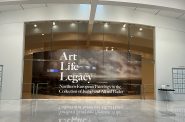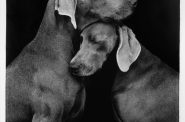Hockney’s Talking Picture of Another Sort
Diana Sanchez visits the Milwaukee Art Museum to ponders a David Hockney photo collage in this One Piece at a Time episode.

David Hockney (English, b. 1937) Christopher Isherwood Talking to Bob Holman, Santa Monica, 1983 Chromogenic prints on board 44 x 64 x 2 in. (111.76 x 162.56 x 5.08 cm) Purchase, Richard and Ethel Herzfeld Foundation Acquisition Fund and funds in memory of Betty Croasdaile and John E. Julien M2005.136 Photo credit John R. Glembin
Go to an art museum, pick a work, stand before it for a long time. Tell us what you see. TCD’s One Piece at a Time series began with that thought in the summer of 2010. TCD senior editor Tom Strini handled the One-Piece duties then and in 2011. In the winter and spring of 2012, Strini worked with a class of graduate students in art at UWM. They did the One Piece drill at the Milwaukee Art Museum, wrote draft essays, then survived a writer’s boot camp with Strini. We’re publishing the results, one piece at a time. In this installment, Diana M. Sanchez considers David Hockney’s “Christopher Isherwood Talking to Bob Holman, 1983, Santa Monica.”
David Hockney collaged hundreds of postcard-size photographs to depict fractional moments in Christopher Isherwood Talking to Bob Holman, Santa Monica, 1983. Each photograph, approximately 4 x 6 inches, serves as a pixel to compose a scene of three men in a living room. Hockney was inspired by cubism and their idea to depict time as various happenings.
In the photo-collage, two men sit on a wicker chair. We see a third man in profile on the left. Hockney stacked several photographs of their faces to reveal at least four facial expressions and moments of body language. The men smile, look, move and talk to each other. The dynamic views of the men suggest they are caught up in an interesting conversation. Coffee, flowers, a magazine, kids’ drawings and pastries rest on a table before them. The objects, in contrast with the faces, remain static. Hockney has edited by omission. He left broad gaps in the composition and directs the eye to what he considers important.
In the eighties, Hockney moved away from painting to explore the photographic medium. He pushed the idea of photography as tool to depict the passage of time rather than the singular, frozen moment, which photography traditionally captures. The results are astonishing photo-collages that let the eyes see different views and times within the same composition.
Art
-
Exhibit Tells Story of Vietnam War Resistors in the Military
 Mar 29th, 2024 by Bill Christofferson
Mar 29th, 2024 by Bill Christofferson
-
See Art Museum’s New Exhibit, ‘Portrait of the Collector’
 Sep 28th, 2023 by Sophie Bolich
Sep 28th, 2023 by Sophie Bolich
-
100 Years Of Memorable Photography
 Sep 18th, 2023 by Rose Balistreri
Sep 18th, 2023 by Rose Balistreri















